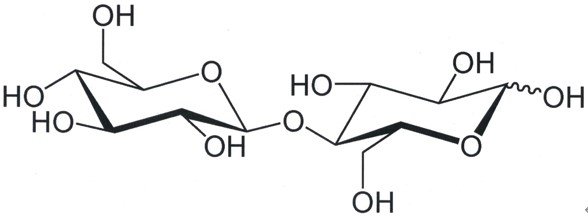



Cellobiose is a disaccharide composed of two glucose molecules linked by a β-1,4-glycosidic bond, which is a partial hydrolysis product of cellulose and a sugar naturally found in plant cell walls. Compared with glucose alone, cellobiose is structurally more stable due to its two glucose molecules being tightly linked by glycosidic bonds. It is a special type of carbohydrate that isn't digested and absorbed by the human body, while it helps maintain normal intestinal function by stimulating intestinal peristalsis and promoting the movement of food in the digestive tract. Moreover, cellobiose is fermented by probiotics to produce beneficial short-chain fatty acids, which provide energy for intestinal cells to maintain the integrity of the intestinal mucosal barrier and have anti-inflammatory and anti-tumor effects.
 Fig.1 The structure of cellobiose. (Wikipedia)
Fig.1 The structure of cellobiose. (Wikipedia)
Gas chromatography (GC) and liquid chromatography (LC) are applied to separate and quantify cellobiose. The chromatographic analysis methods have simple sample pretreatment, small sample amount, and low detection limit, which is especially suitable for the detection of trace samples.
It is a common method for determining the content of cellobiose. For example, cellobiose is hydrolyzed into monosaccharides using specific enzymes such as cellulase, galactase, and fructose, which are quantified using colorimetric methods.
Cellobiose biosensors are constructed by enzymatic hydrolysis to achieve specific detection.
Several other analytical methods are applied to cellobiose, for example, mass spectrometry (MS), gel permeation chromatography (GPC), and electrophoresis, which provide information on the molecular weight, structure, and composition of cellobiose.
 Fig.2 Cellobiose analysis service. (CD BioGlyco)
Fig.2 Cellobiose analysis service. (CD BioGlyco)
Paper Title: Real-time measurement of cellobiose and glucose formation during enzymatic biomass hydrolysis
Technology: Amperometric biosensors
Journal: Analytical Chemistry
IF: 8.008
Published: 2021
Results: Amperometric biosensors allow continuous measurement of cellobiose during enzymatic hydrolysis. The author employed an [Os(2,2'-bipyridyl)2Cl] Cl-modified polymer and cellobiose dehydrogenase to fabricate a cellobiose biosensor, which can accurately and specifically detect cellobiose. In addition, the authors also used high-performance anion-exchange chromatography and pulsed amperometric detection (HPAEC-PAD) method to simultaneously determine cellobiose. The results showed that the content of cellobiose determined by the biosensor was supported by HPLC analysis, while the effect of accumulation of exogenous substrates (cellobiose or glucose) should be considered in the real-time measurement process.
 Fig.3 The process of amperometric biosensors. (Chang, et al., 2021)
Fig.3 The process of amperometric biosensors. (Chang, et al., 2021)
CD BioGlyco provides mature and accurate cellobiose analysis services for our clients, meanwhile, our experts also provide free advice on clients' projects. Please feel free to contact us in time if you want to know more about our services.
References:
